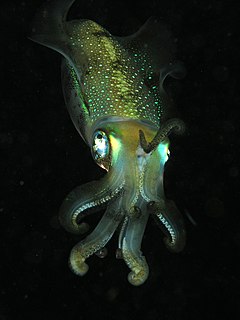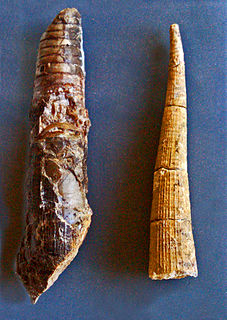| Hemichoanella Temporal range: Arenig | |
|---|---|
| Scientific classification | |
| Kingdom: | Animalia |
| Phylum: | Mollusca |
| Class: | Cephalopoda |
| Subclass: | Nautiloidea |
| Order: | Orthocerida |
| Family: | Baltoceratidae |
| Genus: | Hemichoanella Teichert and Glenister (1954) |
The Genus Hemichoanella is a small, extinct, orthoconic nautiloid cephalopod from the Lower Ordovician of Western Australia assigned to the orthoceratoid family, Baltoceratidae . Hemichoanella and the Baltoceratidae are part of the subclass of once diverse and numerous shelled cephalopods known as the Nautiloidea.

Nautiloids are a large and diverse group of marine cephalopods (Mollusca) belonging to the subclass Nautiloidea that began in the Late Cambrian and are represented today by the living Nautilus and Allonautilus. Nautiloids flourished during the early Paleozoic era, where they constituted the main predatory animals, and developed an extraordinary diversity of shell shapes and forms. Some 2,500 species of fossil nautiloids are known, but only a handful of species survive to the present day.

A cephalopod is any member of the molluscan class Cephalopoda such as a squid, octopus or nautilus. These exclusively marine animals are characterized by bilateral body symmetry, a prominent head, and a set of arms or tentacles modified from the primitive molluscan foot. Fishermen sometimes call them inkfish, referring to their common ability to squirt ink. The study of cephalopods is a branch of malacology known as teuthology.

Western Australia is a state occupying the entire western third of Australia. It is bounded by the Indian Ocean to the north and west, and the Southern Ocean to the south, the Northern Territory to the north-east, and South Australia to the south-east. Western Australia is Australia's largest state, with a total land area of 2,529,875 square kilometres, and the second-largest country subdivision in the world, surpassed only by Russia's Sakha Republic. The state has about 2.6 million inhabitants – around 11 percent of the national total – of whom the vast majority live in the south-west corner, 79 per cent of the population living in the Perth area, leaving the remainder of the state sparsely populated.
Hemichoanella is characterized by its straight, smooth longiconic shell with a circular cross section, large marginal siphuncle and sutures with deep narrow ventral lobes. Septal necks are hemichoanitic, the source of the name, and reach halfway to the previous septa. Connecting rings are thick and uniform, each extending from the tip of a septal neck to the tip of the preceding neck. (T&G 1954)

The siphuncle is a strand of tissue passing longitudinally through the shell of a cephalopod mollusk. Only cephalopods with chambered shells have siphuncles, such as the extinct ammonites and belemnites, and the living nautiluses, cuttlefish, and Spirula. In the case of the cuttlefish, the siphuncle is indistinct and connects all the small chambers of that animal's highly modified shell; in the other cephalopods it is thread-like and passes through small openings in the walls dividing the chambers.
Hemichoanella was named by Teichert and Glenister in 1954 (T&G 1954) for specimens found in Emanuel Creek, Kimberley Division, Western Australia. The type species, Hemichoanella canningi (Teichert & Glenister) is named in honor of Alfred Canning, who from 1906 to 1908, explored the eastern part of the Desert Basin and who discovered and opened up the Canning Stock Route.

Alfred Wernam Canning was a Western Australian government surveyor. Born at Campbellfield north of Melbourne, he started work in New South Wales as a cadet surveyor and in 1893 joined the Western Australian Department of Lands and Survey.

The Canning Stock Route is a track that runs from Halls Creek in the Kimberley region of Western Australia to Wiluna in the mid-west region. With a total distance of around 1,850 km (1,150 mi) it is the longest historic stock route in the world.
Hemichoanella is considered a particularly advanced baltoceratid (T&G 1954) which differs from Baltoceras in having longer septal necks.
Baltoceras is a member of the Ellesmerocerida, included in the family, Baltoceratidae. The shell of Baltoceras is slender with a subcircular cross section, straight transverse sutures, and a large siphuncle in contact with the venter. Septal necks are short but not vestigial; connecting rings are thick; endosiphonal organic deposits are unknown.
